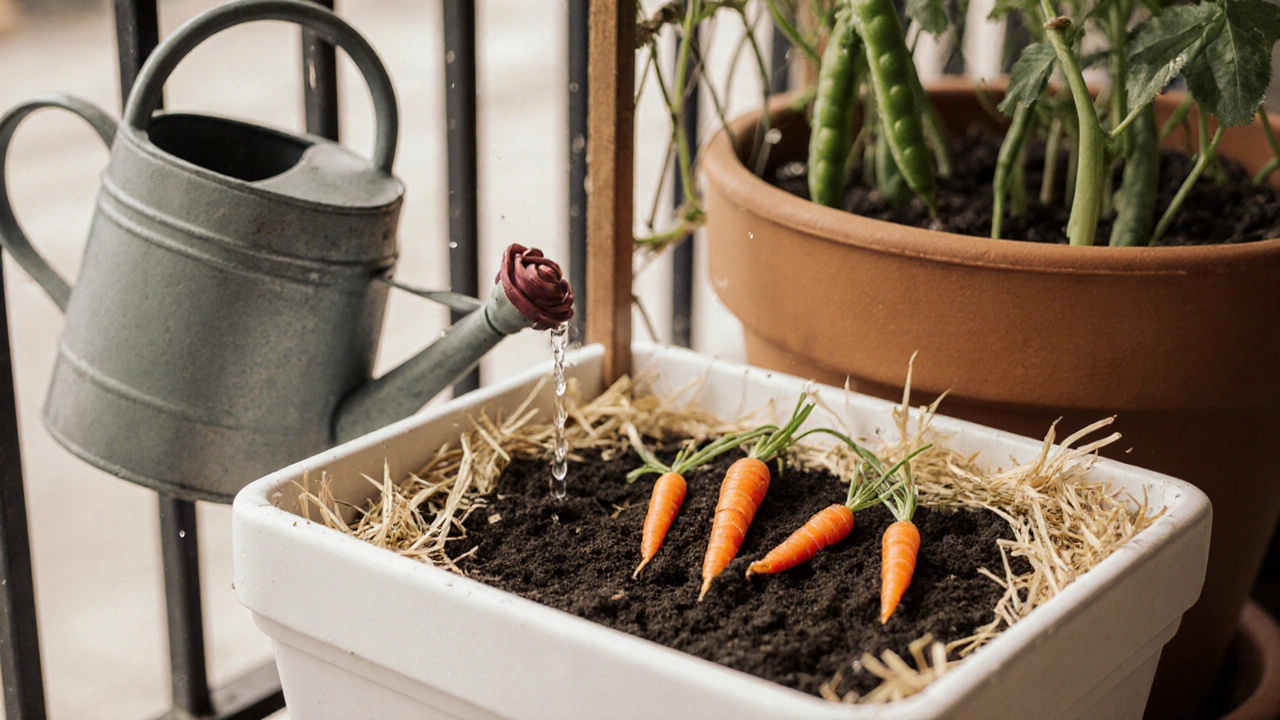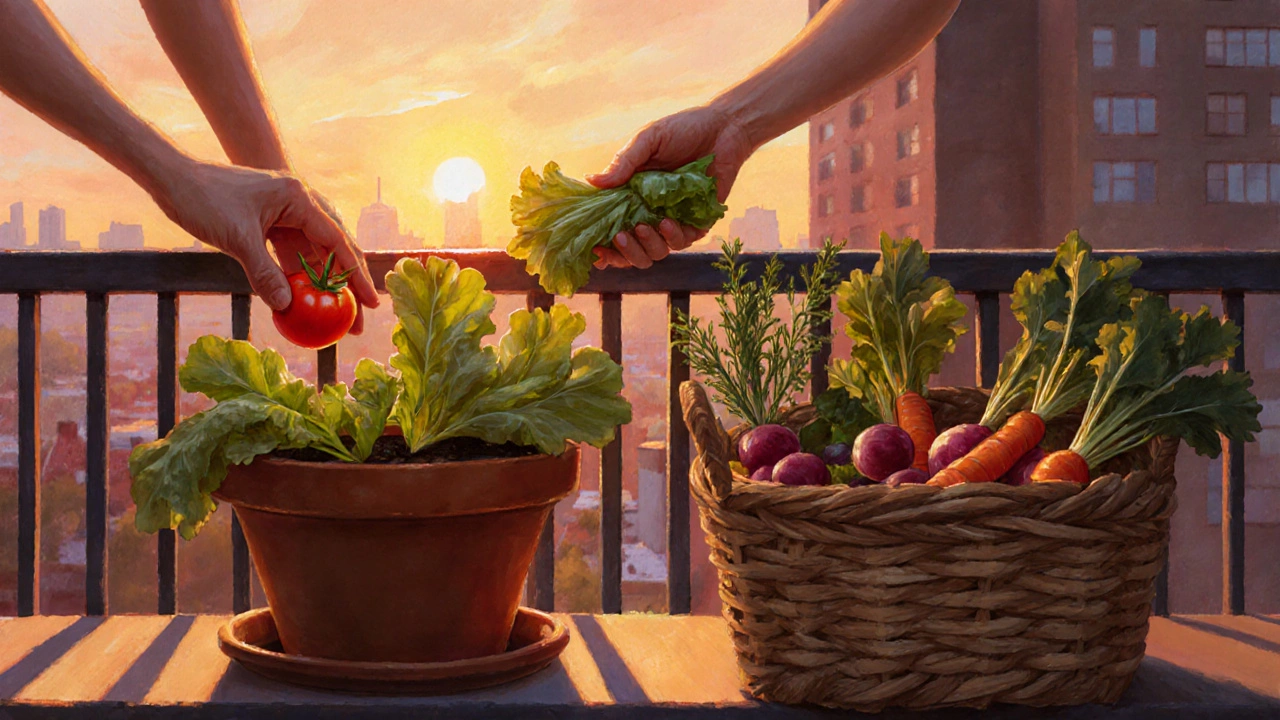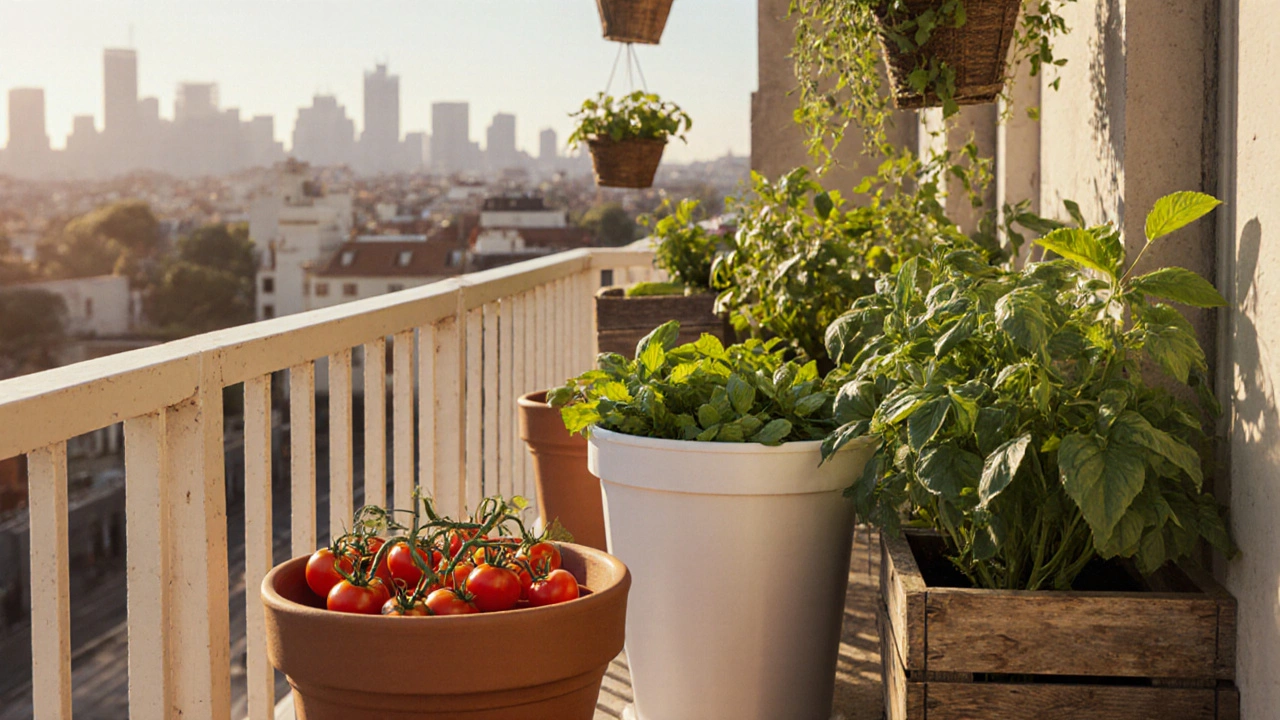Balcony Vegetable Selector
Find Your Perfect Balcony Vegetables
Answer these quick questions to get personalized recommendations for your balcony garden.
Your Recommended Balcony Vegetables
Quick Care Tips: Water consistently, fertilize every 2-3 weeks, and watch for pests early.
Looking for balcony vegetables that thrive in small spaces? Whether you have a sunny railing in Manchester or a shaded nook on a city flat, the right pick can turn a modest balcony into a fresh food source. This guide walks you through the top veggies, how to set them up, and tricks to keep them happy all season.
Quick Takeaways
- Choose fast‑growing, compact varieties like cherry tomatoes, salad greens, and baby carrots.
- Use containers at least 12‑18inches deep with lightweight, well‑draining potting soil.
- Match plants to sunlight: full‑sun (6‑8h) for fruiting veg, partial shade for leafy greens.
- Water consistently, mulch to retain moisture, and feed with a balanced organic fertiliser every 2‑3weeks.
- Watch for common pests - aphids and slugs - and act early with neem oil or hand‑picking.
Choosing the Right Veggies for Your Balcony
Not every garden staple fits a balcony box. The best candidates are those that stay small, produce quickly, and tolerate the occasional wind gust. Below are the top performers, grouped by growth habit.
- Cherry tomatoes - dwarf varieties such as ‘Tiny Tim’ stay under 2ft and keep producing all summer.
- Salad greens - lettuce, arugula, and spinach sow continuously for fresh leaves every few weeks.
- Peas - sugar snap or snow peas climb a small trellis, saving floor space.
- Herbs - basil, mint, and chives thrive in pots and add flavor to meals.
- Baby carrots - choose ‘Little Finger’ or ‘Thumbelina’, which need only 6‑8inches of depth.
- Radishes - ready to harvest in under a month, perfect for quick turnover.
If your balcony gets less than 4hours of direct sun, stick to shade‑tolerant greens and herbs. For sunny decks, add fruiting veg like peppers, dwarf beans, or even a small cucumber trellis.

Containers and Soil Essentials
The container you pick is more than a decorative box; it determines drainage, root space, and temperature stability. Aim for pots that are at least 12‑18inches deep for root‑bearing veg and wider than 12inches across for spreading crops.
- Container material - plastic is lightweight and retains moisture, while terracotta is porous but can dry out fast in windy conditions.
- Potting soil - use a mix of peat moss, perlite, and compost. Avoid garden soil, which compacts and drains poorly.
- Drainage holes are a must. If your pot lacks them, drill a few ¼‑inch holes in the bottom and add a layer of gravel.
For dwarf tomatoes and peppers, add a slow‑release fertiliser pellet (around 2lb per 10‑gal container) at planting time. This gives a steady feed without the risk of over‑fertilising.
Light, Water & Nutrition Basics
Light is the single biggest factor. Here’s a quick rule: fruit‑bearing veg need 6‑8hours of direct sun; leafy greens can manage 3‑5hours.
| Vegetable | Sunlight Needed | Typical Harvest Time |
|---|---|---|
| Cherry tomatoes | 6‑8h full sun | 70‑80days |
| Lettuce (leaf) | 3‑5h partial sun | 30‑45days |
| Snow peas | 5‑6h full sun | 60‑70days |
| Basil | 5‑6h full sun | 60‑90days |
| Baby carrots | 4‑6h full sun | 50‑60days |
| Radishes | 4‑6h full sun | 20‑30days |
Watering should be deep but infrequent - aim for the soil to dry out slightly between sessions. In Manchester’s autumn, a morning soak twice a week usually suffices, but hot summer spells may need daily checks.
- Watering - use a watering can with a rose head to avoid displacing soil.
- Fertiliser - a balanced 10‑10‑10 organic blend works for most veg; apply a tablespoon per gallon of water every 2‑3weeks.
- Mulch with straw or shredded bark to keep the surface cool and reduce evaporation.

Layout, Companion Planting & Harvest Timing
Maximise space by stacking vertically. A small trellis against the railing supports peas and dwarf tomatoes. Place shallow‑rooted herbs like thyme and oregano in the front, letting deeper‑rooted carrots sit behind.
Companion planting isn’t just garden folklore - it can deter pests and boost growth. For example, plant basil next to tomatoes to repel whiteflies, and intersperse lettuce with radishes to break up pest cycles.
Keep a simple calendar: sow lettuce every 2‑3weeks, harvest leaves as needed, and rotate crops every season. This continuous sow‑and‑reap loop ensures you never run out of fresh greens.
Common Problems and Simple Fixes
Even on a small balcony, issues pop up. Here are the most frequent and how to handle them.
- Aphids - spray a diluted neem oil solution (1tsp per litre water) early morning.
- Slugs - scatter crushed eggshells around the pot rim; they act as a barrier.
- Root rot - caused by water‑logged soil; improve drainage and let soil dry between waterings.
- Leaf scorch - often from too‑intense afternoon sun; provide a light shade cloth during peak heat.
When you notice yellowing leaves, first check water levels, then examine for nutrient deficiencies. Adding a teaspoon of compost tea can revive nutrient‑starved plants.
Frequently Asked Questions
Which vegetables give the quickest harvest on a balcony?
Radishes and leafy lettuce can be ready in 20‑45days, making them perfect for fast turnover.
Do I need a balcony rail for container gardening?
A sturdy ledge or rail is helpful, but you can also use a free‑standing pot rack or tiered shelf that sits on the floor.
How much sunlight does a dwarf tomato need?
At least 6hours of direct sun daily; without it, fruit set and size will be limited.
Can I grow potatoes on a balcony?
Yes, use a deep (12‑18in) container and ‘container potatoes’ varieties. They need frequent watering and full sun.
What is the best organic fertiliser for balcony veg?
A balanced 10‑10‑10 compost‑based blend or a liquid kelp extract applied every 2‑3weeks works well.
Ready to turn your balcony into a mini‑farm? Pick a couple of the veggies above, grab a suitable container, and start sowing. With the right light, soil, and a bit of care, you’ll be harvesting home‑grown produce straight from your rails in weeks.

